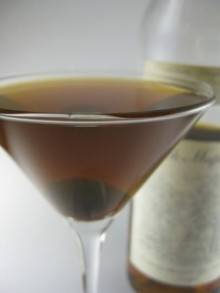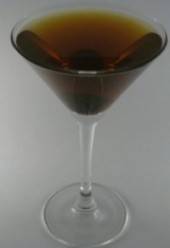Writing a column on The Manhattan is pretty much the equivalent of me taking a bye for the week, so this one is going to be short and sweet. The Manhattan is one of David Embury’s six basic drinks, and I would go further than that — it’s one of the two classic cocktails that everyone in this country is familiar with (the Martini, of course, being the other). The fame is not undeserved. A Manhattan is essentially no harder to produce than an Old-Fashioned, and significantly more forgiving. It’s also the only drink that can be reliably ordered in almost any bar, although you have to be careful to make sure that the Angostura bitters make it in. I once had a bartender swear up and down that bitters had no place in a Manhattan. This is, of course, nonsense.

One of the prime virtues of the Manhattan is its accessibility. Assuming you’re not one of those people whose first, traumatic drinking experience was with whiskey, there is nothing difficult about this drink. It’s warm (figuratively, of course), sweet, and adult. It’s as cool as a Martini without the austerity. And it takes easily to variation and experimentation, although I have nothing but unkind words to say about the version made with Jim Beam Red Stag that someone slipped me at Boltini’s (it tasted like Dr. Pepper). Play with the ratio of whiskey to vermouth, try switching in different bitters (orange are nice, cherry-vanilla are better), or add dashes of absinthe or maraschino liqueur. You can even play around with switching out bases. I’m particularly fond of a version called the Guyana, using aged demerara rum instead of whiskey.
Like all things worth pondering (the origin of the Martini is another), the provenance of the Manhattan is somewhat mysterious. An excellent birth-myth has it being invented for a banquet hosted by Jennie Jerome, Winston Churchill’s mother, at the Manhattan Club, to celebrate Samuel J. Tilden’s inauguration as New York Governor. Unfortunately for Churchill’s stature in the drinking universe (which, honestly, is already well-established), this would have coincided almost exactly with the time of his birth, in England, and so must be disregarded. It is extremely likely that the Manhattan was in fact invented at the Manhattan Club, but beyond that, and a general date of around 1880, we know little. We can only say that the Manhattan is one of the most thriving of pre-Prohibition cocktails.
It is historically accurate, therefore, to make a Manhattan with rye whiskey, rather than bourbon. Many modern mixologists will claim that this is the only way to make a Manhattan, that a bourbon Manhattan is too sweet or less complex. But here’s the thing. My thesis research (so I can speak authoritatively) is on the flavor profile of rye whiskey. And the flavor profile of rye whiskey is pretty similar to that of bourbon. I have conducted sensory tests that show bourbon and rye are not readily distinguishable. My girlfriend and I have run some very enjoyable double-blind Manhattan tastings that seem to indicate the same thing. The most important thing is not whether you’re using bourbon or rye, but whether you like the base, since it’ll be roughly two thirds of the drink. If you feel like trying out a rye whiskey — and there are a number of tasty, affordable ryes — this is a great excuse, but don’t feel like you have to. It’s just a drink, for goodness’ sake.
 The Manhattan
The Manhattan
2 oz American whiskey (rye or bourbon)
1 oz Italian vermouth
2 dashes Angostura bitters
Combine all ingredients in a mixing glass, fill with ice, and stir. Strain into a cocktail glass and twist a strip of orange or lemon peel (traditionally, orange for bourbon and lemon for rye, but who really cares?) over the drink, then drop it in. If you have homemade brandied cherries, or even reputable store-bought ones, go ahead and use one for garnish, but for the love of whichever deity you hold dear, don’t use one of those artificially-colored, plastic, undead things. The fake almond taste can only hurt your drink.
A well-made Manhattan surpasses verbal description, so just sip, sigh, and repeat.
And, if somehow you get bored of Manhattans (this should actually be impossible), you can always swap in Scotch to make a Rob Roy (if you also switch Benedictine, a French monk’s liqueur, for the Angostura, you’ll have a Bobby Burns) or switch in aged tequila (reposado will do, añejo is better) for a Tequila Manhattan (they can’t all have cool names).








